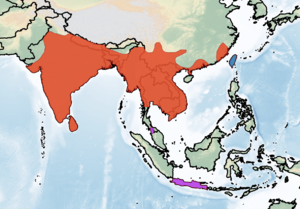Greater bandicoot rat facts for kids
Quick facts for kids Greater bandicoot rat |
|
|---|---|
 |
|
| Bandicota indica in southern India | |
| Conservation status | |
| Scientific classification | |
| Genus: |
Bandicota
|
| Species: |
indica
|
 |
|
The greater bandicoot rat or Indian bandicoot rat (Bandicota indica) is a type of rodent. It belongs to the Muridae family, which includes many kinds of rats and mice. You can find these rats in many countries across Asia. This includes Bangladesh, China, India, Indonesia, Laos, Malaysia, Myanmar, Nepal, Sri Lanka, Taiwan, Thailand, and Vietnam.
These rats can grow quite large. Their body can be about 27–29 cm long. Their tail can be even longer, up to 28 cm. It's important not to confuse them with bandicoots from Australia. Those are marsupials, which are different kinds of animals. The Australian bandicoots were actually named after these rats!
What Does It Look Like?
The greater bandicoot rat has dark gray-brown fur on its back. It also has many long, black hairs mixed in. Its sides are gray with a few long, black hairs. The fur on its belly is short and light gray.
It has a dark, bare, and scaly tail. Its feet are dark, but its claws are light-colored. Young bandicoot rats are much lighter in color than the adults.
In the Sinhala language from Sri Lanka, this rat is called maha uru-meeya. This means "pig-rat." In Malayalam from India, it's called panni-eli or thorappan. These names also mean "pig-rat." In the Nepali language, it's one of several animals called chuchundra.
Life Cycle of the Greater Bandicoot Rat
A female greater bandicoot rat can have many litters of babies in her lifetime. She usually has between 8 and 10 litters. Each litter can have 8 to 14 rat pups.
When they are born, the young pups are blind and have no fur. They grow quickly! Young rats become old enough to have their own babies when they are about 50 to 60 days old. Adult bandicoot rats usually live for about one year.
How Do Greater Bandicoot Rats Behave?
Greater bandicoot rats are known for being large and aggressive. When they feel threatened, they raise the long hairs on their backs. They also make grunting sounds. If you put two of these rats in a cage together, they will likely fight.
These rats are so aggressive that even some dogs and cats are afraid of them. They often live near people's homes, like in gardens or yards. You can commonly find them near garbage bins. Sometimes, you might see them on the side of the road.
They are very good at digging burrows. Their digging habits can cause a lot of damage to the ground and even to floors. They can even tunnel through brick and stone walls! You can often tell they are around by their large, noticeable burrows.
These rats are not picky eaters. They will eat many things, including household trash, grains, and vegetables. They can be a big problem for farms, especially poultry farms. They can also carry germs that might make people sick.


